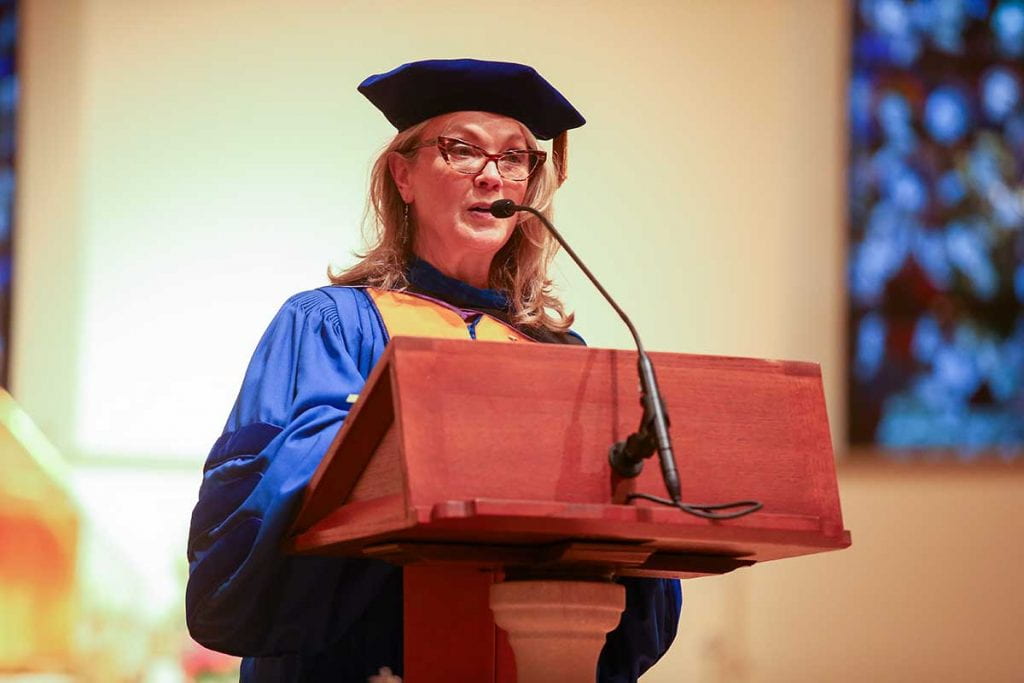May 03, 2022
Dr. Joan Branham remarks on Phi Beta Kappa installation
By Joan Branham, Ph.D.
Professor, Art and Art History
President, Gamma Chapter of Rhode Island
As an art historian who studies theories of sacred space, I can’t help but begin my remarks by noting the beautiful architectural space that surrounds us. I want to thank our chaplain, Father Justin Bolger, for opening the chapel’s doors to us today. When St. Dominic Chapel was being built, I interviewed the architects who noted that their inspiration was the 6th-century Byzantine church of San Vitale in Ravenna, which also is octagonal in structure with a lantern gallery above and stonework on the exterior. I have the pleasure of teaching San Vitale every semester in the art history survey course, and it’s always rewarding when students discover the connection between a very tangible part of their own campus life here and an ancient art historical monument (which I will also say is worth 10 points on the exam!).
But more than this being a well-designed architectural space, I think it’s fitting that we hold the Phi Beta Kappa installation here for a couple of reasons. St. Dominic Chapel is named after the founder of the Dominican Order — an order that possesses a long history of teaching and scholasticism, a passion for the pursuit of truth, and a deep love of learning. Since the Middle Ages, Dominican philosophers have been leaders of intellectual life.
Yet there’s more about this space. Exactly like the Byzantine structure of San Vitale, the exterior of St. Dominic Chapel is minimal in its decoration, unpretentious, simple in its beauty. The architects of San Vitale also crafted an unadorned exterior that gives way to a beautiful, luminous, and artful interior. In fact, we read that ancient theologians and architects believed that liturgical structures should mirror meaning in our own lives, that is to say, that superficial façades are not as important or worthy of attention as the cultivation, nurturing, and embellishment of the inner life, the life of the mind, spirit, and heart.

In some ways, that describes an education in the liberal arts and sciences. The goal is not about producing superficial, material appearances, or a flashy label to be printed on a resumé after graduation. A liberal arts education creates a way of being in the world that students will take with them for a lifetime. It is a transformational training across the arts, humanities, natural, and social sciences that only begins in college but continues for many years beyond. It prepares students to reflect deeply about complex matters, to consider and analyze all the evidence before coming to a judgment, to think critically and fairly, to express oneself thoughtfully and with purpose, and to solve difficult problems in a very complicated world. In essence, a liberal arts education prepares students to become responsible, productive, and engaged global citizens.
The word liberal in liberal arts is from the Latin liber — meaning “free, unrestricted,” such as the Statue of Liberty, a symbol of freedom that we all know today. A liberal arts education in antiquity meant subjects in the arts and sciences that were considered essential for a free person to know. Providence College has embraced this mission since its beginnings in 1917 when Rhode Island granted Providence College its charter: “To promote virtue, piety, and learning,” in “the liberal …. arts and sciences.” PC’s origins align directly with the values of Phi Beta Kappa. And the installation of a Phi Beta Kappa chapter tonight is a testament to the College’s unwavering commitment to the arts and sciences, situating PC among the nation’s most prestigious academic institutions.
This recognition comes after a long, intensive, and rigorous application process with a Phi Beta Kappa site review team visiting our campus and interviewing faculty, staff, students, and College leaders. I want to thank the entire community for uniting in this effort, and recognize my friend and colleague — Dean Sheila Liotta — for her leadership and partnership on the application process, a labor of love we have both shared. I’d also like to recognize Phi Beta Kappa member Melanie Sullivan of Institutional Research for her invaluable assistance on the application. And for tonight’s organization, I thank the staff in Arts & Sciences and College Events for their incredible energies and assistance.
Soon, we will hear about our foundation members who have given unparalleled service to the College’s liberal arts mission. We also recognize our first class of Phi Beta Kappa students for their accomplishments.
Every student here tonight has majored in an arts and sciences discipline. Every student here has shown proficiency in a foreign language — an invaluable skill in our increasingly connected global setting. Every student here has achieved academic excellence at the highest level of magna or summa cum laude. And every student here has demonstrated good character and integrity throughout their college career.
Students, I began with reference to some architectural details of this space. I conclude with the doors of this chapel as the threshold from which you will navigate your path ahead. As you step outside those doors tonight, I am confident that you will dedicate yourselves not to superficial distractions, but to cultivating the inner self in order to work for the common good, to utilizing your critical and analytical skills to create justice and equity in society, and to fostering inquiry and curiosity to lead to a life-long love of learning. Congratulations!
More about Phi Beta Kappa





